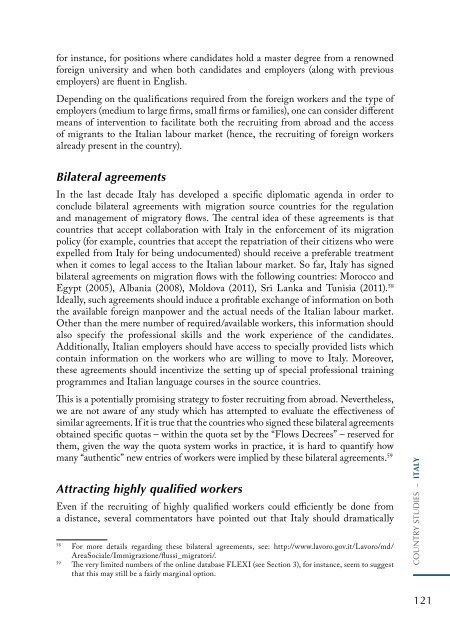International Organization for Migration (IOM)
International Organization for Migration (IOM)
International Organization for Migration (IOM)
Create successful ePaper yourself
Turn your PDF publications into a flip-book with our unique Google optimized e-Paper software.
<strong>for</strong> instance, <strong>for</strong> positions where candidates hold a master degree from a renowned<br />
<strong>for</strong>eign university and when both candidates and employers (along with previous<br />
employers) are fluent in English.<br />
Depending on the qualifications required from the <strong>for</strong>eign workers and the type of<br />
employers (medium to large firms, small firms or families), one can consider different<br />
means of intervention to facilitate both the recruiting from abroad and the access<br />
of migrants to the Italian labour market (hence, the recruiting of <strong>for</strong>eign workers<br />
already present in the country).<br />
Bilateral agreements<br />
In the last decade Italy has developed a specific diplomatic agenda in order to<br />
conclude bilateral agreements with migration source countries <strong>for</strong> the regulation<br />
and management of migratory flows. The central idea of these agreements is that<br />
countries that accept collaboration with Italy in the en<strong>for</strong>cement of its migration<br />
policy (<strong>for</strong> example, countries that accept the repatriation of their citizens who were<br />
expelled from Italy <strong>for</strong> being undocumented) should receive a preferable treatment<br />
when it comes to legal access to the Italian labour market. So far, Italy has signed<br />
bilateral agreements on migration flows with the following countries: Morocco and<br />
Egypt (2005), Albania (2008), Moldova (2011), Sri Lanka and Tunisia (2011). 58<br />
Ideally, such agreements should induce a profitable exchange of in<strong>for</strong>mation on both<br />
the available <strong>for</strong>eign manpower and the actual needs of the Italian labour market.<br />
Other than the mere number of required/available workers, this in<strong>for</strong>mation should<br />
also specify the professional skills and the work experience of the candidates.<br />
Additionally, Italian employers should have access to specially provided lists which<br />
contain in<strong>for</strong>mation on the workers who are willing to move to Italy. Moreover,<br />
these agreements should incentivize the setting up of special professional training<br />
programmes and Italian language courses in the source countries.<br />
This is a potentially promising strategy to foster recruiting from abroad. Nevertheless,<br />
we are not aware of any study which has attempted to evaluate the effectiveness of<br />
similar agreements. If it is true that the countries who signed these bilateral agreements<br />
obtained specific quotas – within the quota set by the “Flows Decrees” – reserved <strong>for</strong><br />
them, given the way the quota system works in practice, it is hard to quantify how<br />
many “authentic” new entries of workers were implied by these bilateral agreements. 59<br />
Attracting highly qualified workers<br />
Even if the recruiting of highly qualified workers could efficiently be done from<br />
a distance, several commentators have pointed out that Italy should dramatically<br />
58 For more details regarding these bilateral agreements, see: http://www.lavoro.gov.it/Lavoro/md/<br />
AreaSociale/Immigrazione/flussi_migratori/.<br />
59 The very limited numbers of the online database FLEXI (see Section 3), <strong>for</strong> instance, seem to suggest<br />
that this may still be a fairly marginal option.<br />
country studIes – ITALY<br />
121


